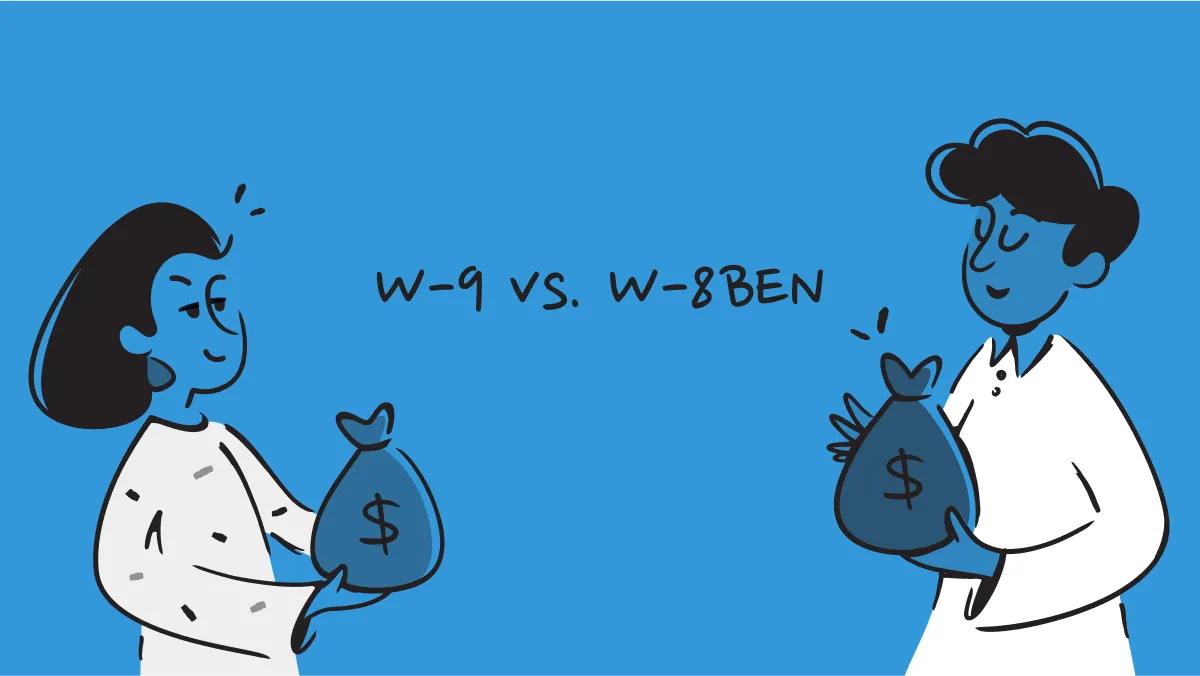W-9 vs. W-8BEN: Which IRS Form Should You Use for US and Foreign Payees?

Before you pay a contractor whether they’re based in the US or abroad, you’re responsible for collecting the correct IRS form. Using the wrong form can lead to excessive withholding, IRS penalties, or gaps in year-end reporting.
This guide breaks down the difference between Form W-9 and Form W-8BEN, explains when each one applies, and outlines the risks of getting it wrong. If your startup works with US freelancers or international contractors, knowing which form to collect and how to use it will help you stay compliant as your contractor base grows.
What’s the Core Difference Between Form W-9 and Form W-8?
The main difference comes down to who fills out the form and what tax status they are certifying. If you’re paying a US citizen, resident, or US-based business, you’ll need Form W-9. This form confirms the recipient’s US tax status and provides their Taxpayer Identification Number (TIN) for year-end reporting.
If you’re paying a non-US individual, you must collect Form W-8BEN instead. This form certifies that the payee is a foreign resident and, in many cases, allows them to claim reduced withholding under a tax treaty between the US and their home country.
Here’s a quick summary of differences between W-9 vs. W-8BEN:-
Who Should Submit Form W-9 or Form W-8BEN, and When?
Form W-9 must be collected from any US-based person or entity before making a payment. This includes independent contractors, freelancers, consultants, and incorporated businesses that operate within the United States. The form certifies that the recipient is a US taxpayer and provides the TIN required for IRS reporting.
Form W-8BEN is required when you’re paying a foreign individual for services. It certifies that the payee is not a US person and allows them to claim reduced withholding under a tax treaty if applicable. If the payee is a foreign business entity (not an individual), they must instead complete Form W-8BEN-E.
Here’s when you should use W-9, W-8BEN, and W-8BEN-E
- Form W-9: Use this when paying US freelancers, consultants, sole proprietors, LLCs, or corporations.
- Form W-8BEN: Use this when paying non-US individuals who are providing services to your US-based business.
- Form W-8BEN-E: Use this when paying foreign entities (like foreign LLCs or corporations), not individuals.
How Does Tax Withholding Differ Between Form W-9 and Form W-8BEN?
The form your contractor submits directly affects how much tax you must withhold from their payments.
For US payees who submit Form W-9, you typically don’t withhold taxes. Instead, they self-report their income using a 1099 form at year-end unless they’re subject to backup withholding due to incorrect or missing taxpayer information.
For foreign individuals who submit Form W-8BEN, the default IRS rule requires you to withhold 30% of US-source income. However, this rate can be reduced, or even eliminated, if the individual claims tax treaty benefits on the form and provides a valid foreign tax identification number.
Do Form W-9 and Form W-8BEN Get Filed with the IRS?
Neither Form W-9 nor Form W-8BEN is filed directly with the IRS.
These forms are collected and retained by the paying business, your startup is responsible for securing them before making payments and for using the information to complete year-end tax reporting.
Even though these forms aren’t submitted to the IRS immediately, they’re considered essential documentation. If you don’t collect and store them properly, you risk non-compliance, penalties, or incorrect tax reporting.
Here’s what to do with the forms:-
- Collect the form before issuing any payment. Make sure contractors submit the correct form based on their residency status.
- Store completed forms securely. These are legal documents and must be available for IRS inspection if requested.
- Use W-9 data to prepare Form 1099. The Taxpayer Identification Number (TIN) on Form W-9 is used to report income paid to US contractors.
- Use W-8BEN data to prepare Form 1042-S. This form reports US-sourced income paid to foreign individuals, along with any withholding applied.
- Request updated forms when information changes. For example, if a contractor changes tax status, country of residence, or business type, a new form must be collected.
When Do Form W-9 and Form W-8BEN Expire or Need to be Updated?
Form W-9 does not expire but you must request a new one if the contractor’s information changes. For example, if their business name, tax classification, or TIN changes, a new W-9 must be submitted before issuing further payments.
Form W-8BEN, on the other hand, expires after three years, even if the payee’s information hasn’t changed. You’ll need to track these expiration dates and request renewals to keep your records valid and maintain proper withholding rates:-
- W-9 - No fixed expiration; update if TIN, name, or status changes
- W-8BEN - Expires after 3 years or when residency/status changes
Failure to update an expired or invalid form may result in IRS penalties or default withholding requirements, 30% for foreign payees, 24% for US payees without valid TINs.
Common Mistakes to Avoid with Form W-9 and Form W-8BEN
Incorrectly managing W-9 and W-8BEN forms can result in over-withholding, under-reporting, or IRS compliance issues. Startups working with international contractors or scaling fast often overlook key details leading to penalties or avoidable administrative work during tax season.
Watch out for these common mistakes:
i) Collecting Form W-9 from foreign contractors
Only US persons and entities should submit Form W-9. Asking a non-US contractor to fill it out can cause incorrect reporting and missed withholding obligations.
ii) Accepting Form W-8BEN from US persons
US citizens, residents, and entities should never use Form W-8BEN. If someone submits it in error, you must request a corrected W-9 before making payment.
iii) Failing to renew W-8BEN forms every 3 years
Unlike W-9s, W-8BEN forms expire. If you don’t track expiration dates, you may be forced to apply full 30% withholding by default, even if a treaty benefit previously applied.
iv) Ignoring backup withholding rules for invalid W-9s
If a W-9 is missing or has an incorrect TIN, you are required to apply backup withholding at 24% for US contractors until a valid form is submitted.
v) Skipping form collection for small or one-time payments
Even if the payment is modest, IRS rules still require you to collect the proper form if the payee is eligible for a 1099 or 1042-S.
How Inkle Helps Startups Handle Contractor Tax Forms and Compliance
Managing tax forms for a mix of US and international contractors can get messy, especially if you’re scaling quickly or handling cross-border payments. Inkle simplifies the process by automating form collection, applying IRS rules correctly, and keeping your startup compliant across jurisdictions.
With Inkle, you can:
- Identify which form each contractor needs. Based on the contractor’s location and tax residency, Inkle flags whether a W-9, W-8BEN, or W-8BEN-E is required.
- Collect and store completed forms securely. Contractors can submit forms directly through Inkle’s platform, and your records are stored for audit-readiness.
- Apply correct withholding for foreign payees. Inkle calculates and tracks the correct withholding rate, including treaty benefits where applicable.
- Track expiration dates and request renewals. You’ll be alerted when a W-8BEN is about to expire, so you can stay compliant without scrambling.
- Generate IRS-compliant 1099 and 1042-S reports. Use the collected form data to prepare year-end reports accurately. No spreadsheet chaos.
Book a demo with Inkle to automate Form W8 and W9 and stay compliant without the stress.
Frequently Asked Questions
Who needs to fill out IRS Form W-9?
Any US citizen, resident alien, sole proprietor, or US-based business receiving payment from a US company must submit Form W-9. It provides the Taxpayer Identification Number (TIN) used to report payments on Form 1099.
When should I use Form W-8BEN instead of W-9?
Use Form W-8BEN if you are a non-US individual providing services to a US company. This form certifies your foreign status and may allow you to claim reduced withholding under a tax treaty.
Is Form W-8BEN filed with the IRS?
No. Form W-8BEN is submitted to the US company making the payment. The business uses it to determine withholding and to complete Form 1042-S at year-end.
Does Form W-8BEN expire?
Yes. It expires after three years or sooner if the contractor’s tax residency or other key details change. You must collect a new form before continuing to pay under reduced withholding.
What happens if I collect the wrong form from a contractor?
You may apply the wrong withholding rate, misreport income, or fail to comply with IRS rules. In some cases, your startup may face penalties or be held responsible for uncollected tax.
Can Inkle help with W-9 and W-8BEN compliance?
Yes. Inkle helps startups determine the correct form, collect it securely, track expiration dates, apply proper withholding, and generate 1099 or 1042-S reports - all in one platform.




